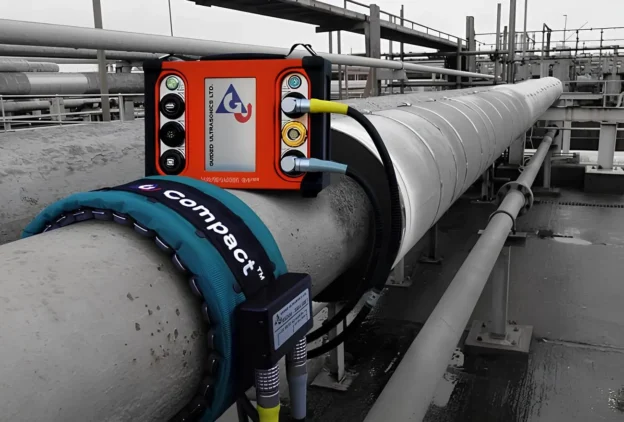Pipeline integrity is essential to the energy, petrochemical, and process industries. Critical lines often extend for hundreds of meters and run through locations that are difficult to reach— buried underground, covered with thermal insulation, or installed on elevated structures. Many of these inaccessible sections go unchecked for years, increasing the risk of undetected damage.
Conventional inspection methods rely on direct access to the area of interest, which typically requires costly, disruptive, and time-consuming preparations, such as system shutdowns, insulation removal, or excavation. Guided Wave Testing (GWT) offers a smarter alternative.
With access at just a single location, GWT can screen long sections of pipe for corrosion, wall loss, and other cross-sectional changes. It is non-intrusive and highly efficient, making it ideal for assessing extensive, hard-to-reach pipelines.
For over 25 years, Guided Ultrasonics Ltd. (GUL) has been at the forefront of this technology. The company’s patented innovations have shaped how GWT is used around the world— not only by delivering industry-leading equipment, but also by helping define international technical standards.
How guided waves work in pipe inspection
Guided waves are ultrasonic waves that travel along the walls of structures—such as plates, pipes, or rails—rather than passing directly through them. Their propagation is guided by the physical boundaries of the material, allowing specific wave modes to cover long distances from a single access point. This makes them particularly effective for rapid, wide-area inspection of structural integrity.
Guided Wave Testing (GWT) is a Non-Destructive Testing (NDT) method that uses these waves to screen assets for corrosion. In pipeline screening, a ring of transducers is placed around the pipe at a single location to transmit and receive signals. When the transmitted waves encounter a change in cross section caused by corrosion, a weld, or a support, part of the signal reflects back to the ring.
These returning echoes are analyzed based on amplitude, timing, and angular distribution. The location of any feature is clearly indicated by its distance from the ring and its clock position around the pipe. Severity is estimated by considering signal amplitude, calibrated against weld reflections, and circumferential spread. Results are shown as A-scan traces and an Unrolled Pipe Display—a C-scan-style view that maps signals around the pipe—for intuitive interpretation.
GWT is effective in detecting general corrosion, localized wall thinning, and internal deposits, and structure features such as welds, clamps, or supports—anything that causes a change in cross-sectional area. Its ability to identify all these features makes this method a powerful tool for efficiently screening large areas and pinpointing regions that may require closer examination.
Inspection range and sensitivity
Range and sensitivity are influenced by several factors, including pipe characteristics, such as overall condition, coating, geometry, and support type, as well as the setup used during the test.
On clean, straight, aboveground pipe, inspections can extend beyond 100 meters in each direction (200 meters total). In older pipework, or where corrosion, deposits, or attachments are present, a more typical range is around 30 meters each way. Buried pipe introduces additional attenuation due to the surrounding soil, but ranges of up to 20 meters per direction are still achievable—greater distances are possible when the soil is decoupled from the pipe.
Sensitivity refers to the system’s ability to detect small changes in the pipe wall and depends largely on the signal-to-noise ratio. A stronger signal relative to background noise improves the likelihood of identifying real features while avoiding false calls. This ratio is affected by the condition of the pipe and influenced by the frequency of the guided wave signal.
Guided wave inspection operates in a low ultrasonic frequency range, typically between 20 and 80 kHz. Within that band, frequency selection plays an important role. Lower frequencies travel farther, but are less responsive to small changes in cross section. Higher frequencies improve sensitivity, but are more easily attenuated and scattered by general corrosion. To manage this trade-off, GUL systems sweep across multiple frequencies in each test to maximize both coverage and detection performance.
Applications
Guided wave inspection is especially useful in situations where conventional inspection methods are difficult or impractical. It is routinely used on insulated lines, road or wall crossings, elevated pipework, buried pipelines, offshore risers, and subsea segments—areas where full access is restricted or expensive to achieve. It is also a valuable tool for prioritizing inspections in long pipe runs and monitoring known areas of concern over time.
Key benefits
With minimal access and setup, large sections of pipe can be screened rapidly without interrupting the flow of the line. GWT reduces the need for surface preparation, insulation removal, or excavation—lowering cost and operational impact. Its ability to detect changes anywhere around the pipe circumference, combined with long-range coverage, makes it an effective screening tool for both one-off surveys and ongoing monitoring. By identifying potential issues early, smarter maintenance decisions are possible and follow-up inspections can be targeted where they are really needed.
Practical considerations
Certain factors can influence the effectiveness of guided wave inspection and should be considered when planning a test. Geometric features such as closely spaced welds, clamps, supports, bends, or flanges can limit inspection range or affect signal clarity. Similarly, poor pipe condition, heavy corrosion, or thick coatings can reduce signal strength and may influence how much of the pipe can be effectively screened from a single location.
Reliable interpretation requires a clear understanding of the pipe environment and appropriate system setup. Well-trained inspectors play a key role in recognizing relevant signals and confidently distinguishing them from expected reflections. With proper technique and informed analysis, guided wave testing delivers meaningful insights that support more targeted and efficient follow-up inspection activities.
Leadership in guided wave technology
Guided Ultrasonics Ltd. (GUL), founded in 1999, has been the leading force behind the advancement, innovation, and practical adoption of guided wave inspection worldwide. The company’s origins are rooted in pioneering research that first established the method at Imperial College London. Over the past 25 years, GUL systems have been deployed globally, supporting pipeline integrity in the oil and gas, power generation, and transportation sectors.
GUL’s contribution extends well beyond equipment. It has helped shape industry practice through the development of inspection standard procedures, operator training standards, and test protocols now widely used in the field. The company has actively contributed to the development of international and national standards through organizations such as ISO, ASME, API, PRCI, and BSI—helping promote consistency and quality in guided wave inspection.
GUL operates an industry-leading training program. Its courses, delivered globally and developed by experienced professionals, combine hands-on learning with field-based context. These courses equip users not only with the practical skills to operate the technology, but also with the judgment needed to interpret results with confidence and accuracy.
Wavemaker® G5: Focused on field performance
The Wavemaker® G5 is the latest-generation guided wave inspection instrument developed by Guided Ultrasonics Ltd. Built for fast, reliable pipe screening in real-world conditions, the G5 retains the rugged dependability of earlier models while introducing a completely renewed system architecture. Shaped by years of field experience and user feedback, it features a streamlined hardware platform, a modern user interface, and tools designed to improve productivity and data quality, all without compromising on the principles that make guided wave testing effective.
Faster data, sharper insights
Signal processing has been refined in the G5. Software- assisted feature recognition supports confident analysis, even in challenging conditions such as buried or coated pipelines. Advanced signal handling and improvements in frequency response enhance defect visibility in high-attenuation environments, such as soil-covered pipe. Optimized data capture permits simultaneous acquisition of low- and high- frequency sweeps when using CompactTM rings and TRIO modules. This speeds up fieldwork and consolidates multi-frequency results into a single, analysis-ready dataset file for clearer defect visibility
Smart guidance, expert oversight
From simplified connections and automatic transducer detection to on-screen prompts and test validation tools, the G5 reduces setup time and simplifies routine tasks. Procedure-driven workflows guide inspectors through setup, testing, and analysis, helping ensure consistent results from day one. Advanced users benefit from real-time oversight and Wi-Fi- enabled remote access, allowing teams to focus on accurate data collection and timely decision-making.
Inspection at your fingertips
Compact and field-ready, the G5’s glove-friendly, toughened touchscreen houses a fully integrated onboard computer, allowing data collection and analysis to be performed directly on the device. For added flexibility, laptop operation remains available, though the onboard software makes it optional rather than required.
Versatile by design
Fully compatible with GUL’s range of screening rings and non- ATEX gPIMS® monitoring sensors, the G5 provides continuity with existing equipment while expanding flexibility. Dual hot-swappable batteries and remote calibration capabilities keep inspections running without pause, whether for routine screening or integration into live monitoring programs.
Engineered for the field, built for what’s next
The Wavemaker® G5 represents a focused evolution in guided wave testing—engineered to meet the demands of modern inspection teams through faster workflows, clearer results, and seamless integration into maintenance strategies. It delivers more than field efficiency by providing consistent, traceable data that helps prioritize follow-up, reduce unnecessary interventions, and keep inspections aligned with operational priorities.
Shaping the future of pipeline integrity with wavemaker® G5
As industries evolve toward more efficient, data-driven asset management, the Wavemaker® G5 stands out as more than an advanced inspection tool—it serves as a foundation for better decisions. Guided wave testing offers actionable insight through long-range, non-intrusive inspection, delivering capabilities that conventional methods cannot match. The result is more efficient screening, better-targeted interventions, and traceable data that supports long-term asset planning.
Designed for the realities of the field, the G5 allows earlier detection of hidden threats and more cost-effective, focused responses. Whether deployed for one-off inspections or integrated into monitoring programs, it helps teams stay ahead of deterioration, allocate resources more effectively, and maintain control over pipeline condition without unnecessary disruption.
More than a technical upgrade, the G5 reflects a change in inspection philosophy—from reactive interventions to proactive, condition-based strategies. In environments where access is limited, downtime is costly, and reliability is critical, the G5 empowers asset teams to act with confidence, supporting safer, smarter, and more sustainable operations while extending the life of critical infrastructure.
Este artículo fue desarrollado por y publicado Guided Ultrasonics Ltd. como parte de la quinta edición de la revista Inspenet Brief Agosto 2025, dedicada a contenidos técnicos del sector energético e industrial.


